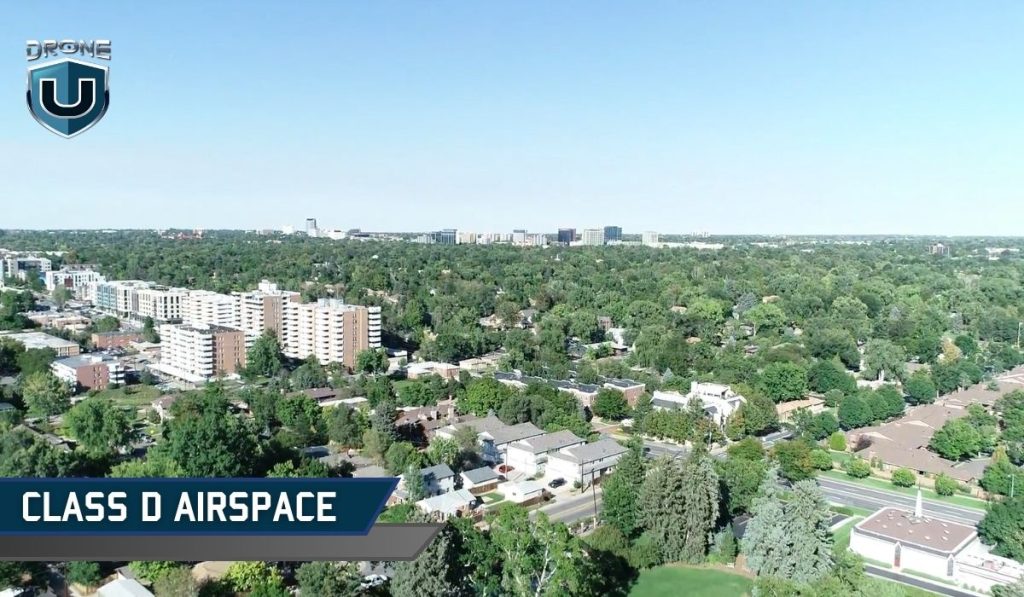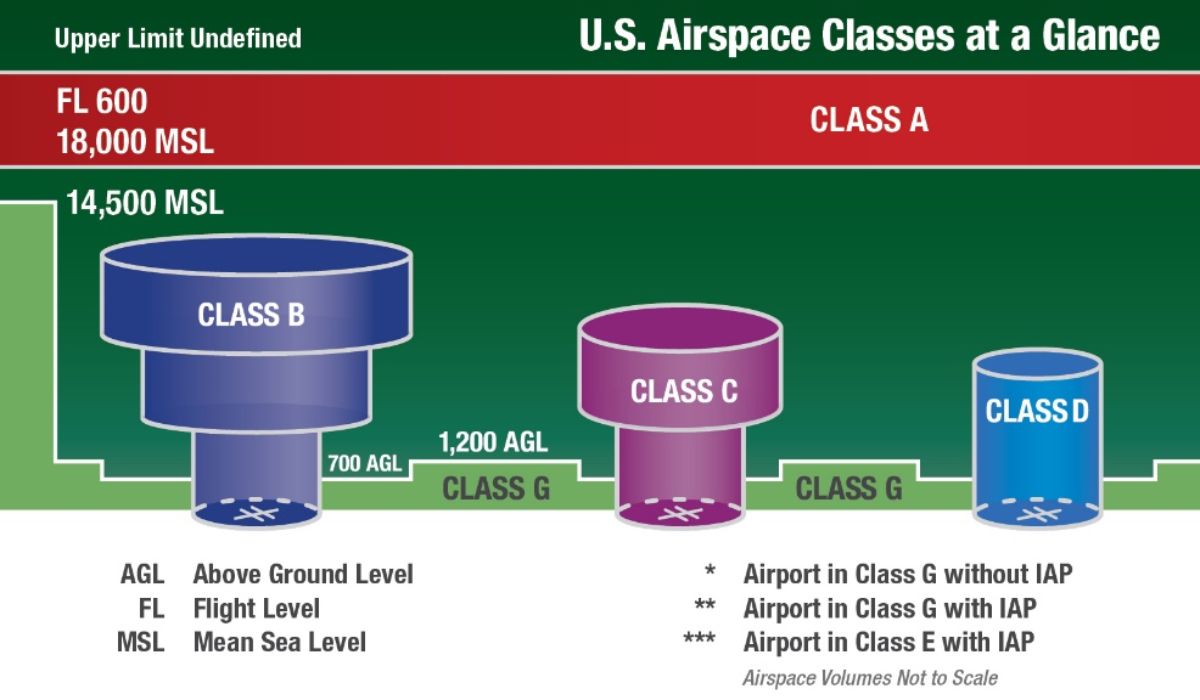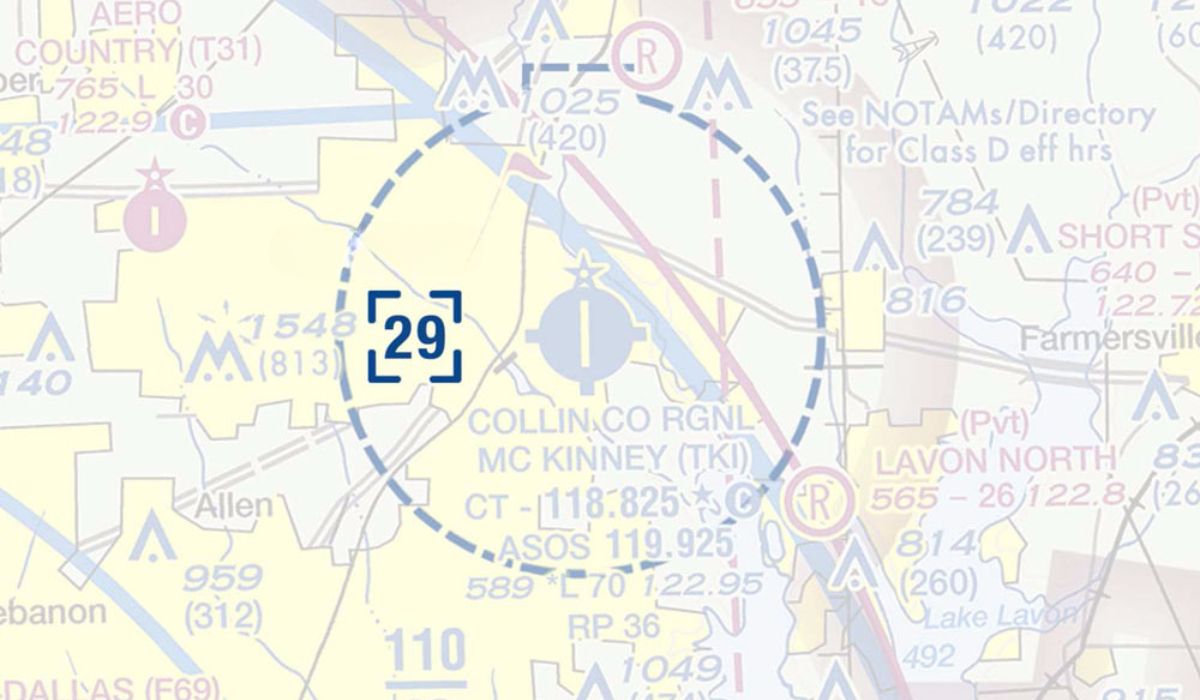
Drone flying offers an exhilarating sense of freedom, but the world’s airspace is a complex network of three-dimensional segments, each of which is further divided into seven airspace classes known as Class A, B, C, D, E, F, and G.
Class D or Delta airspace, in particular, is an essential category as this airspace is designed to facilitate organized traffic flow in and out of the airport with controlled towers.
This means that you must understand the rules and regulations before flying into Class D airspace, ensuring safety and regulatory compliance.
In this comprehensive guide, we will help you understand what is Class D airspace, and the basic legal requirements you need to get well-versed with to fly in it.
Let’s get started.
What is Class D Airspace?

Class D airspace consists of Air Traffic Control (ATC) towers to conduct airport operations safely and efficiently.
Class D airspace includes almost any kind of air traffic, from airlines and corporate traffic to cargo operators and weekend fliers—everyone shares this airspace at many Class D airports.
Its key characteristics include the following:
- Vertical Limits: Think of it as a cylindrical cake layer in the sky, usually extending from the surface up to 2,500 feet above ground level (AGL). However, its dimensions may vary based on local air traffic patterns and terrain.
- Horizontal Boundaries: About 4 to 5 nautical miles from the airport’s center.
- Operating hours: Often operates full-time (24 hours) or part-time.
- Weather Minimums: According to Visual Flight Rules (VFR), visibility must be at least three statute miles, and cloud clearance must be at least 500 feet below, 1,000 feet above, and 2,000 feet horizontally.
- Speed limit: Class D airspace speed limit must stick to a maximum of 200 knots, when at or below 2,500 feet AGL, within 4 nautical miles of the primary airport.
But why is it important? Let’s find out.
Why is Class D Airspace Important for Drone Pilots?
Well, most accidents in controlled airspace occur due to a lack of knowledge and understanding of airspace rather than intentional violations.
Class D airspace represents such a highly controlled airspace; that’s why you cannot fly within this zone without prior authorization from the FAA.
Drones can operate in this airspace only with proper ATC authorization that has jurisdiction over that airspace.
Now the question arises, how can you check for Class D airspace? That’s what is covered in the next section.
Where is Class D Airspace Located?
Class D airspace, commonly found around smaller airports, presents a unique challenge for pilots. Shaped as a cylinder around the airfield with highly controlled operational towers and extending 2,500 feet above the airport elevation, it can be tricky to navigate within this controlled airspace.
How to Identify Class D Airspace?

The most accurate identification of Class D airspace is necessary for safe and efficient flight operations. The best way to achieve this is by using aeronautical charts like AirMap or any other flight planning apps that provide precise airspace locations.
A blue dashed circle on aeronautical maps symbolizes the airport, serving as a visual indicator. Around that, Class D airspace is depicted with a two-digit number surrounded by square enclosed brackets.
Having understood the basics, let’s discuss whether you can fly a drone in Class D.
Requirements for Flying Drones in Class D Airspace
There are the following requirements you need to take into account before operating your drone in Class Delta areas:
1. Permission to Fly in Class D Airspace
To fly a drone, you’ll need to get prior approval through airspace authorization by the FAA.
This approval allows you to request permission from ATC to operate flying in controlled airspace. Authorization can be obtained for a single location or area governed by a single ATC.
You can easily obtain FAA authorization through the LAANC (Low-Altitude Authorization and Notification Capability) system.
It’s a partnership between some private drone companies (like DJI, Skyward, and Kittyhawk) and the FAA that allows you to apply for instant airspace authorization using a mobile or web application.
If LAANC is not available at your desired location, you can fill out the FAA’s online airspace authorization form and wait for it to be processed. Depending on the complexity of your request, this may take at least 90 days or even longer to process.
2. Drone Pilot Qualifications and Part 107
To fly drones in controlled airspaces, you must comply with the FAA’s Part 107 rules. These rules outline the qualifications needed for a commercial drone pilot, including remote pilot certification issued by the FAA.
This ensures that you are well-versed in the different airspace classes. Understanding these classifications will prepare you to operate in controlled airspaces with altitude restrictions and line-of-sight requirements.
3. Equipment and Safety Considerations
Although there are no specific transponder requirements for most drones flying in Class D, it’s still essential to follow these basic equipment safety rules:
- Use reliable GPS systems.
- Follow Class D weather minimums.
- Stay alert and have a clear understanding of your surroundings.
- Adhere to visual flight rules (VFR) visibility requirements, this includes maintaining at least three statute miles of visibility and staying clear of clouds (500 feet below, 1,000 feet above, and 2,000 feet horizontally).
- Pre-plan emergency landing spots in case of an emergency.
Radio Procedures and Communication
Flying a drone in controlled airspaces often requires a high level of communication to ensure safe flying surroundings for manned aircraft.
So, here are some drone flying communication best practices you must follow in controlled airspaces:
1. Stay in Touch with ATC (Air Traffic Control)
While you don’t always need to interact with ATC, still there are some specific communication procedures in Class D airspace to follow:
- In case you are flying close to manned aircraft routes, always establish two-way communication with ATC.
- When a tower reaches you while flying, follow the right communication protocols and understand what they want to communicate.
- Always maintain a safe distance from manned aircraft.
2. Follow Class D Airspace Communication Requirements
If your drone is near manned traffic, or if ATC specifically shares any requests, then you have to use the two-way radio communication system.
In such situations, you must have an understanding of basic Class D airspace communication requirements like:
- Acknowledgment: Reply to the instructions given by ATC to confirm understanding.
- Urgent Request Handling: Intentions or requests (e.g. landing or transitioning through).
- Altitude: Confirm & maintain a specified altitude (usually below 400 feet AGL for drones).
- Hold Position: Stop movement if instructed by ATC.
3. Have an Understanding of Step-by-Step Radio Procedures
Use these basic radio procedure steps to maintain clear communication and a safe flight:
- Initial Contact: Before beginning drone operation, call the control towers to request clearances for drone operations.
- State Intentions: Briefly describe the purpose of your flight, location, and altitude.
- Listen for ATC: Wait for ATC to grant clearance, provide information, or request further details.
- Acknowledge ATC: Confirm ATC’s instructions by repeating them back.
- Report Changes and Exist: If you have any changes in your flying operations or you’ve completed your flight, notify ATC.
Conclusion
Flying in regulated areas like Class D Airspace can be challenging at first. However, with the correct understanding of different airspace classes, rules, and regulations, you can ensure not only safe but also successful drone operations, providing a sense of security and reassurance.
Drone U’s drone pilot training program resources are specially designed to support you in foundation building, ensuring you can navigate your path with confidence, preparedness, and competence.
Check out our group training and one-on-one training programs, here.
Frequently Asked Questions
1. Can I fly a drone in Class D airspace?
Yes, you can fly drones in Class D airspace, but it’s crucial to remember that this requires pre-authorization from the FAA. This step is of utmost importance as Class D airspace is a high-traffic area due to its proximity to airports. Additionally, you’ll need permission from ATC.
It’s essential to stick to these strict regulations related to flying altitude, weather minimus, speed limits, and visibility standards, as these ensure the safety of all flying operations in Class D airspace.
2. How do I get approval to operate a drone in Class D airspace?
To get approval to operate a drone in Class D airspace, you can use these two different processes:
1) Use the LAANC System: for instant approval for operations, by following these steps:
- Download an approved LAANC provider mobile app or use their web portal.
- Enter your flying location, time, and altitude details.
- Submit the request. If LAANC covers the location and the operation meets FAA requirements, approval is often granted instantly.
2) Submit a Request through FAA DroneZone: LAANC does not work 100% of the time for every location, in such case follow these steps:
- Create an account on the FAA’s DroneZone website (dronezone.faa.gov).
- Submit a request for airspace authorization, including details like your flight location, date, time, and purpose of flying.
- Await FAA approval, which can take up to 30-90 days or even more, depending on the request’s complexity.
3. What happens in the Class D Airspace when the tower is closed?
In Class D airspace when a tower is closed, the airspace changes. Depending on the airport, this typically reverts to either Class E or Class G airspace.
1. Class E Airspace
ATC usually controls Class E but may have fewer restrictions than Class D airspace.
However, you still need to follow the same rules of visibility and cloud clearance in Class E, but there is no need to maintain two-way communication with ATC.
2. Class G Airspace
Class G is not controlled, meaning you need to operate without any communication with ATC, but still need to follow Visual flight rules (VFR) and maintain visibility with cloud clearance standards.
Remember, when flying in Class E or Class G airspace without ATC guidance, you need to be even more careful and alert.
So, consider using a visual observer to help spot other aircraft in complex airspace around airports.
4. What is the maximum altitude for drone flights in Class D airspace?
The maximum altitude for drone flights in class D airspace is 400 feet above ground level (AGL).
In case you want to exceed this 400-feet limit, then you can seek specific authorization from the FAA, which may require additional approvals from ATC.
However, keep in mind that such permissions are granted only under special circumstances and must comply with necessary safety measures.
5. What is the VFR minimum for Class D?
In Class D airspace, Visual Flight Rules (VFR) minimums for drones are closely set to manned aircraft. Here are the requirements:
Flight visibility: Three statute miles.
Cloud Clearance: The drone must remain at least
- 500 feet below
- 1,000 feet above
- 2,000 feet horizontal
As per FAA, for any drone operation in Class D airspace, maintaining these VFR minimums is essential to keep flying altitude under 400 feet AGL.







Add Your Comment